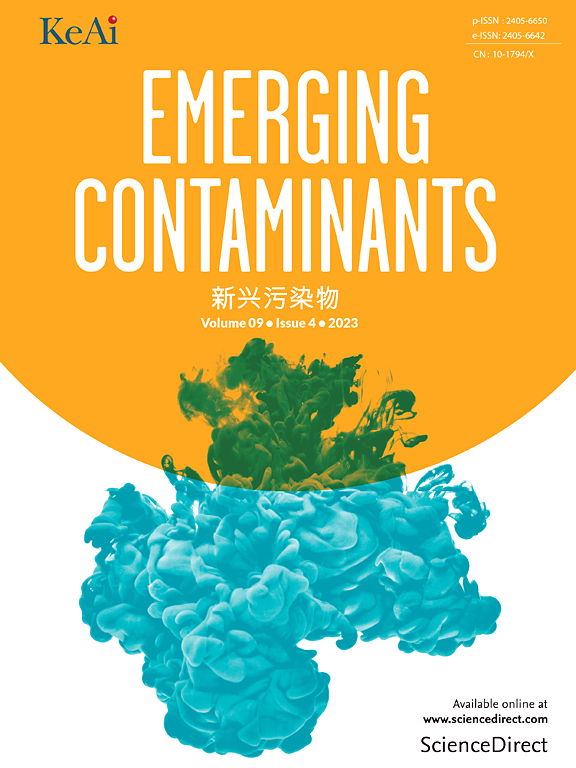PFOA promotes hepatocellular carcinoma cell progression by suppressing ferroptosis via the ATF4/SLC7A11/PDK4 axis
IF 6.9
2区 环境科学与生态学
Q1 ENVIRONMENTAL SCIENCES
引用次数: 0
Abstract
Per- and polyfluoroalkyl substances (PFASs) are persistent pollutants with emerging hepatotoxic and tumor-promoting concerns. Differences in effects between long- and short-chain PFAS on liver tumor progression remain unclear. We examined transcriptomic and functional effects of PFOA (long-chain), GenX (short-chain), and their 1:1 mixture on HepG2 cells exposed to a nominal total concentration of 0.02 mg/L. Using RNA-Seq, qPCR, and assays for proliferation, migration and invasion, we found that PFOA induced the largest number of differentially expressed genes and markedly promoted proliferation, migration and invasion via activation of TNF and insulin-resistance pathways. PFOA also suppressed ferroptosis through upregulation of the ATF4/SLC7A11/PDK4 axis, supported by decreased BODIPY-C11 lipid peroxidation and lower labile Fe2+. GenX showed substantially weaker effects, and the mixture produced intermediate responses consistent with a concentration-addition (dose-dilution) explanation. These findings indicate that PFOA promotes malignant phenotypes of existing liver cancer cells in vitro rather than demonstrating de-novo carcinogenesis, and highlight the need to evaluate tumor-promoting and hepatotoxic effects of PFAS under both single-compound and mixed exposures.

PFOA通过ATF4/SLC7A11/PDK4轴抑制铁下垂,从而促进肝癌细胞的进展
全氟和多氟烷基物质(PFASs)是持久性污染物,具有新出现的肝毒性和促进肿瘤的关注。长链和短链PFAS对肝脏肿瘤进展的影响差异尚不清楚。我们检测了PFOA(长链)、GenX(短链)及其1:1混合物对暴露于名义总浓度为0.02 mg/L的HepG2细胞的转录组学和功能影响。通过RNA-Seq、qPCR和增殖、迁移和侵袭实验,我们发现PFOA诱导了最多的差异表达基因,并通过激活TNF和胰岛素抵抗途径显著促进了增殖、迁移和侵袭。PFOA还通过上调ATF4/SLC7A11/PDK4轴来抑制铁下垂,并通过降低BODIPY-C11脂质过氧化和降低不稳定的Fe2+来支持。GenX表现出明显较弱的效果,混合物产生的中间反应与浓度-添加(剂量-稀释)的解释一致。这些研究结果表明,PFOA在体外促进现有肝癌细胞的恶性表型,而不是表现出去新生致癌作用,并强调有必要评估PFAS在单一化合物和混合暴露下的促瘤和肝毒性作用。
本文章由计算机程序翻译,如有差异,请以英文原文为准。
求助全文
约1分钟内获得全文
求助全文
来源期刊

Emerging Contaminants
Medicine-Public Health, Environmental and Occupational Health
CiteScore
10.00
自引率
6.70%
发文量
35
审稿时长
44 days
期刊介绍:
Emerging Contaminants is an outlet for world-leading research addressing problems associated with environmental contamination caused by emerging contaminants and their solutions. Emerging contaminants are defined as chemicals that are not currently (or have been only recently) regulated and about which there exist concerns regarding their impact on human or ecological health. Examples of emerging contaminants include disinfection by-products, pharmaceutical and personal care products, persistent organic chemicals, and mercury etc. as well as their degradation products. We encourage papers addressing science that facilitates greater understanding of the nature, extent, and impacts of the presence of emerging contaminants in the environment; technology that exploits original principles to reduce and control their environmental presence; as well as the development, implementation and efficacy of national and international policies to protect human health and the environment from emerging contaminants.
 求助内容:
求助内容: 应助结果提醒方式:
应助结果提醒方式:


